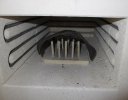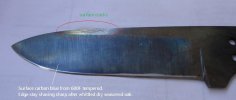Where I see potential problems is in your current HT regime.
Spheroidize the blade and refine the grain by cycling down - Heat to 1525F, hold for ten minutes, and oil quench, heat to 1350F, hold, and quench. Heat to 1250F and hold for one hour. Air cool to 900F and then quench.
The blade is now ready for final HT. Heat to 1500F and hold for 10 minutes. Quench in medium to fast oil. Cool to room temperature and place in dry ice/LN for ten minutes. Allow to warm up to room temperature and temper twice at 400F.
Doing an excess of multiple quenches to refine the grain and multiple cryo treatments is not going to gain anything, but may damage the blade ( especially if using the wrong quenchant).
Here is why blades should be cycled:
First austenitization - about 25°F above the target and a suitable soak time. This will assure full solution of carbides.
Second austenitization - about 25°F above critical with a suitable soak time. This will assure the finest grain. ( repeating this will gain little or nothing)
Third heat is sub-critical, and as close to 1250-1275°F as you can hold it. 30 minutes to one hour here will spheroidize the steel, putting all the carbides into nice bundles. The steel is nowin as fine grain and stress free condition as you can get.
Final austenitization at the target ( 1500F for 52100), soak for sufficient time to allow the carbides to re-distribute ( 10 minutes is normally all that is needed for a carbon steel).
Quench in the PROPER quenchant for the steel. Using a faster quenchant will not gain any hardness, but may damage the steel by introducing great stress and possibly micro-cracks.
Steels with alloy content and potential retained austenite gain a bit from completing the quench by lowering to around -100°F. This is called sub-zero, not cryo. Cryo does nothing for any but the very high alloy stainless steels. The transformation at sub-zero is fast, and there is no need for a long soak.
What is needed is to get the blade warmed back up to room temperature with no stress ( allow to warm up hanging in still air is best), and then IMMEDIATELY temper. Two tempers of an hour each , with cooling to room temperature quickly between tempers, is the final step in HT.
I have made some changes in how I HT in recent years, due to spending some time with metallurgists who are vastly more informed, and who have done some blade specific testing. These are the changes you may have noticed over the last couple of years in my posts:
1) I now heat the blade higher on the first cycle. 1525F is my normal first austenitization. You need to reverse any super-spheroidation that may have been placed in the structure by the factory or your earlier processing ( forging and normalizing). This seems especially important for Aldo's 52100, which comes very spheroidized.
2)My austenitization temperature is now at the higher limit of the charts. This seems to get better quality blades. Many used to use the lowest austenitization as they could, thinking that it made harder blades.. There seems no advantage to this, and some disadvantage. If the chart says 1470-1500F, go with the 1500F. Do not go lower than the metallurgical charts recommend.
3)I cycle the steel down in three steps on all carbon steel blades - 200F above critical, just above critical, and subcritical. There seems to be a divided view on whether it is needed to quench or air cool to 900F on the first two, but it seems that either method gets good results.
4)I water quench from the 900F point in normalizing and in cycling. Slower cooling in air, cooling in sand/ashes/vermiculite, or slow oven cooling can make an undesirable type of pearlite.
5)I immediately do the sub-zero treatment as soon as the blade reaches room temp after final quench. Any delay can stabilize the austenite.
6)Cryo isn't the great thing that was originally thought. Sub-zero is very much a good thing. The eta carbides and other changes for true cryo ( -300F) are apparently all reversed in temper. Using LN is fine, but won't appreciably do more than -100F will.
7)I still temper twice, but have been told that in a blade thickness, one hour each temper is sufficient.
8)Tempering should not be delayed any more than is possible. Getting the blade from quench to temper in the shortest practical time is best. Waiting to cool down the HT oven may be too long. It is best to place the freshly quenched blade in a second oven ( kitchen oven or a toaster oven), to hold it at 300F until the HT oven cools for the temper program to start.



